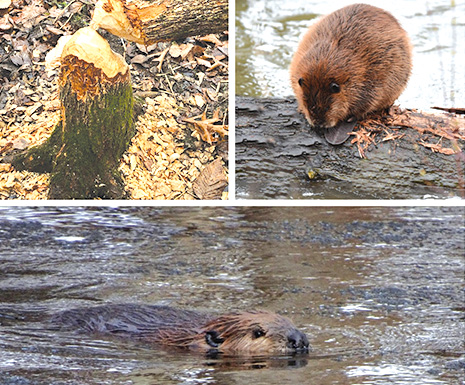Out on the trail this fall, we have been hankering to see some rodents. After much searching, my local favorite, the beaver, graced us with his presence. We saw the signs first, gnawed trees, dammed up streams with a lodge in the middle, expanding waterways. Living up to his reputation of being busy, the beaver had totally reengineered the landscape, making a pond where there was just a little trickle of a stream. And by clamming up, we did get to see a beaver swimming around demonstrating all the grace of Michael Phelps. He sure is adapted for the semiaquatic lifestyle with transparent eyelids that act as goggles, closeable nostrils, webbed feet and a paddle tail. After we had admired him for a while, I needed to launch into a sidebar from my childhood. My folks brought home a two-volume set of books, one entitled The Wonders of Life on Earth, and on afternoons when I was to be practicing reading my Dick and Jane books, I found my way into the pages of the wonder book with all its fold out plates of animals living and extinct. And on one page, I caught a glimpse of an honest-to-God enormous beaver that lived during the last ice age and was the size of a black bear. My hiking group feigns interest in yet another dip into my childhood as we put one foot in front of the other.
But on occasion, I do need to take a breath, and since my trail mates are former teachers, that is the perfect time for them to school me in the historical significance of beavers. When I was in history class, and the professor unfurled the big map in the front of the room, I took that opportunity to think about all things boy while my classmates and friends were bettering themselves by expanding their bank of knowledge. Today, they recall the fur trappers in our country and how they spread across our nation to feed the European desire to wear the finest beaver hats. This demand led to greater exploration by Europeans of our wilderness, even driving Lewis and Clark as they headed westward to pursue fur trading. None of this was a good thing for the beavers, and their numbers declined steadily until the hat makers started to use silk, and beaver pelts fell out of fashion. But beavers can never really let their guard down as many people take exception to their engineering skills when it comes to wetlands and private property.
Honestly, I don’t like to think of the fur trade and what may have happened to the beavers’ kin back a few centuries ago. No wonder I wasn’t listening in history class. Growing up, I had a friend whose brother did some trapping of muskrats. And once during a game of hide and seek, I spotted the pelts stretched out in the lower level of the barn, skin side out on little frames, and my heart sank. I try to keep that memory tamped down. But when it does resurface, I need a way to lift my spirits when I think of all the beavers that ended up as hats. A temporary diversion has me thinking of that wonderfully Canadian dessert called a Beaver Tail. It consists of a hand stretched piece of dough, fried, and topped with whipped cream or chocolate sauce. It’s hard to think of anything else when you take a bite. I suppose if it’s good enough for Neil Young and Justin Trudeau, count me in. And for a few moments, just the thought of a sugar rush clouds my mind, and beaver skin hats are a distant memory. I’d like to keep it that way.
